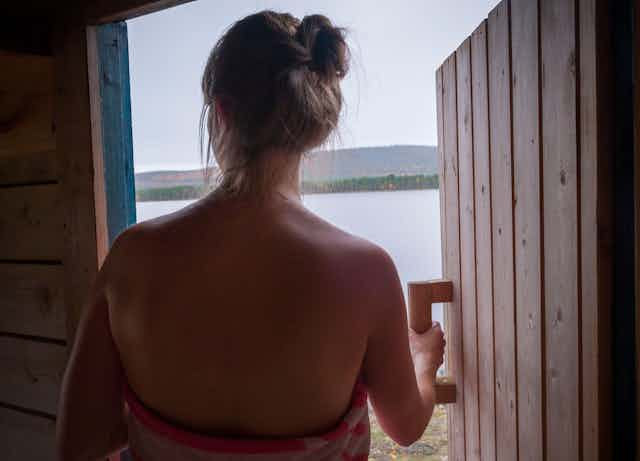I was standing in a forest at night, by a dark lake taking part in a Mother Earth ritual. Shaman drums echoed between the cliffs. The witch leading the ritual suddenly encouraged us to sound like wild animals. The other women seemed to greet this as something predictable and expected. “Stand up, let your inner spirit out, the wild animal within you!” the witch called out. And then she laughed out loud into the darkness – and just howled.
A woman in her 60s, with long blonde tangled hair, looking tough and slender-limbed at the same time, rose to her feet, and with something wild glittering in her eyes, she followed the witch into this transcendental phase of the ritual, and started to howl too.
I was in Hälsingland, a region in southern Sweden’s Norrland (Northland). I travelled there in September 2021, to find out more about a group of people who were staunchly against COVID-19 vaccinations, as part of a four-year research project. A well-known pundit working at a national newspaper had called vaccine sceptics, like the ones I was to meet, “egoistic, ill-bred tearaway teenagers” in a national newspaper. I knew there would be more to them than that, so I wanted to meet them and try my best to understand them.
Understanding Hälsingland itself is key to that understanding, as the lack of work opportunities and the ongoing migration of people to the big cities are big issues for the local population. The same goes for the high death rates connected to drugs among young adults as well as the high (by national standards) suicide rates in the Gävleborg county, to which Hälsingland belongs. The people I met were doing their best to adjust to these issues, but it seemed difficult for them to fully accept the changes which had been wrought over their communities in recent years.

This story is part of Conversation Insights
The Insights team generates long-form journalism and is working with academics from different backgrounds who have been engaged in projects to tackle societal and scientific challenges.
On my first day I met a group of middle-aged women who drove me to a tired old house, painted with “Falu rödfärg”, a traditional red paint used to cover wooden buildings. It was here, ahead of any transcendental ceremonies, where we were going to sauna bathe together.
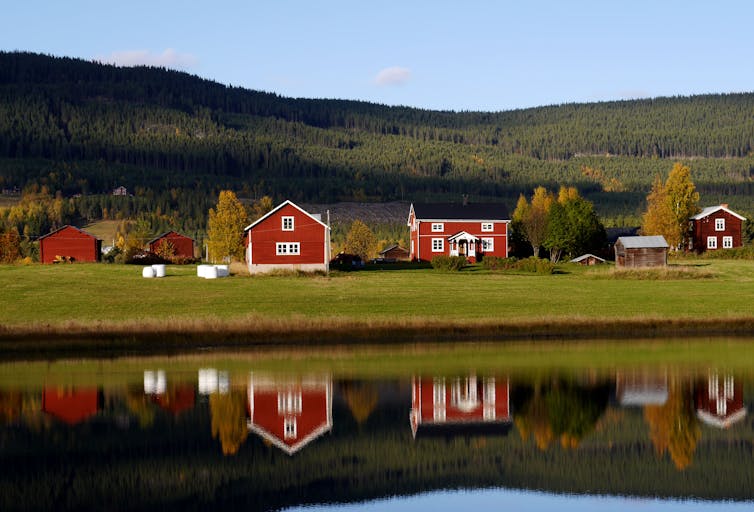
Darkness was falling over the fields and meadows, sparsely located houses and wide-ranging forests. The September evening light tucked in the landscape like a soft blanket. Nowadays, this part of Sweden is connected to words like “depopulated” rather than “rural”. The unemployment rate is high, government welfare has been greatly reduced and some hospitals have been shut down. Some years ago (in a region further north of Hälsingland) parents were even offered courses on how to deliver babies in their car.
The Swedish election that took place in September 2022 exposed the division between the countryside and the cities. People, mostly men, living in rural areas voted for the populist right-wing party, Sverigedemokraterna (The Swedish Democrats) in higher numbers than those living in the cities.
The Swedish Democrats are now Sweden’s second biggest party. This means that Sweden follows in the footsteps of the political development of other Nordic countries, such as Norway and Denmark, towards a less social-liberal politics and more conservative ideology. Immigration and crime have become the topics that all parties, from left to right, seem to identify as the most important.
Still, Scandinavia’s high willingness to take vaccinations against many infectious diseases bear witness of a well-functioning welfare state model. The documented high trust in public authorities certainly played a role when people chose to take the recommended COVID-19 jabs.
My fieldwork among vaccine critical people in Hälsingland took place over a week in a cultural environment that in one sense was familiar to me. My grandmother and her siblings were born in a small Hälsingland-village. I’m Swedish, so there were no language barriers that the women I was with had to overcome, and we share the same national culture. But within cultures, more cultures unfold kaleidoscopically. So, at the same time it was a place I didn’t belong to.
I was a stranger, an academic from the city. Despite this, I was warmly invited into this community of friends that, among many other things, nurtured a strong reluctance towards vaccines. In one way or another, these women were hesitant or critical towards all kinds of vaccinations.
Sauna stories
We started out with some sweating in a hot sauna. The women thought a sauna would be a good start to my trip. They often do this together so it seemed like a natural thing to do. Lit candles decorated the entrance. It felt a bit awkward to undress in front of people I had just met; there is a paradox in being both professional and naked, even for an ethnologist. But the crackling sound of the fire and the overwhelming heat soothed my nerves.
When sitting in this small, hot space together with people I didn’t know and who didn’t know me, I could physically feel how the energy was directed towards me, the stranger coming from the university in the south. Later during the week they gave me the nickname “Lund University”. I spoke to them about my own attitude towards vaccinations: that I take them all without reflecting too much and my children do too. I explained that I was genuinely interested in why they had refrained from vaccines that are voluntary and free of charge in Sweden. I had no mission whatsoever in trying to influence their choice.
I didn’t know the cultural codes in this particular sauna, but sauna bathing is a well-established ritual in Scandinavia that I’ve taken part in enough times to know the procedure. When minutes turned into quarter of an hour, the sweat was forming a small pool on my stomach, and then the natural flow in and out of the sauna began. Litres of water were consumed in greedy gulps. We took outdoor showers, stark naked in the increasing darkness of the garden. The ice-cold water evoked sounds of joy, high-pitched screams and laughter embedded in the surrounding nature.
Half-consciously, I studied their behaviour so that I would blend in as much as possible. Slowly but steadily, I felt more and more included. I could relax, let my guard down.
Suddenly the light chit-chat turned into stories of pain, loss and sorrow. Little by little, this led us into questions of health and vaccines.
Natural and unnatural
Anna* explained that she relied upon the presumption that a natural way of living will protect her and her children from harm. Fresh air, long walks in nature, food that comes directly from the surrounding forest, yoga and meditation, and spending lots of time with your loved ones – all these offer a much better health protection than vaccinations, she claimed. She felt that, in comparison, vaccines were something unnatural.
She explained that living close to nature made her and her friends “better suited” for a stable contact with their inner selves and that, in turn, reflected their contact with nature and their belief in the immune system as “naturally powerful” – as long as you don’t interfere with it. This gave the immune system more of a spiritual meaning.

A low humming sound came from her friends in agreement. The immune system becomes naturally strong here, they all agreed, not due to the national vaccination programmes but because of the closeness to nature in everyday life. Nature was repeatedly referred to as something inherently benign, a Nordic idea that researchers like Jonas Frykman and Orvar Löfgren have investigated as a romantic response to urbanisation.
It also became clear that some of the women had taken the decision to refrain from vaccinations decades ago when their children were small. That was when – as in many other parts of the world – there was a worry that the measles vaccine could cause neurological diseases, like autism. That charge has since been debunked, but its effects appear to have been long-lasting. And now, the unvaccinated sons and daughters of the women I interviewed had left this sparsely populated area to live in bigger cities.
Even though spiritually oriented, these women did not belong to any religious community and were not involved in organised political activities. They were just friends, that, for similar reasons were convinced that vaccinations may be harmful to their health.
When I asked them to describe this conviction in more detail, I was told stories about how nobody knows for sure what vaccines do to the immune system in the long run. Vaccines might even destroy the immune system, depriving it of its natural force to combat diseases, leaving the body unprotected and vulnerable. According to them, vaccines have only one winner – the pharmaceutical industry.
I recognised some of these stories from the internet and from literature I’d read. The fear of vaccinations seems to be formed by and in between information from the public authorities, pro and anti-vaccination campaigns, traditional media, digital forums, discussions at kitchen tables, conspiracies, rumours and contemporary legends. All these blend the rational and emotional reasoning into a personal mixture.
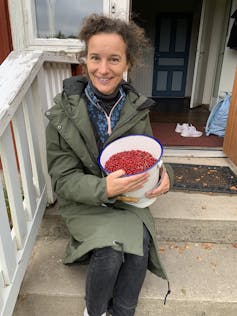
Mother Earth
One windy night at a steep cliff in the forest, where the lake surrounded us in three directions, we gathered to celebrate “Mother Earth”. A middle-aged woman with a warm smile came up to me. She wore a long poncho and bird feathers in her black dyed hair. In her right hand, she held a long feather that she stroked over my coat, from head to toe. Anna, who was accompanying me, told me that this ritual leader was a witch and that the feather stroking is a way of releasing unwelcome spirits. The witch did this to everyone that wanted to join the ritual. A dozen people, mostly women, had parked their cars some 100 metres away and were now gathered among the trees.
We sat in a circle around an unlit bonfire. Being as flexible as a refrigerator, I had severe problems sitting in the lotus position, which most of the other participants managed with ease. When unfolding my aching legs so that they were stretched into the circle, I felt clumsy and undignified. Anna, a yoga instructor, sat beside me with her legs in a neat knot and her fine-limbed spine straight as a tree stem. Her curly, unruly hair was like a halo around her head. I was glad to be there with her. She knew what was about to happen, and I trusted in her to lead me through the experience with kindness.
Then came time to light the bonfire and the torches. The witch rose, seemingly surrounded by flames. Standing for a while in all four points of the compass, she honoured Mother Earth by thanking her for her richness and patience, talking to her rhythmically in a strong and clear voice. Mother Earth was addressed as a subject: not only was she invited to the ritual but she formed the very ground on which it was built. The witch sometimes glanced at her mobile phone to remember the words correctly. I could feel the increasing chilly wind in my hair and small raindrops landed on the backs of my hands. Then the singing in minor began.
A river runs slowly, slowly as a human, a river runs slowly, home to its ocean, give me strength, give me courage to live on this earth, give me strength, give me power, as a river.
A while later we sang a well-known Nordic folksong about a young girl who is herding sheep, one of many similar songs in the Scandinavian folklore treasure chest. The girl in the song walks and walks together with the herd over heaths and mountains. Her stomach is empty but she keeps her spirit up by singing.
Wild animals follow her at a distance, offering protection and evoking fear. In solitude for days, the girl moves slowly between birches, aspen and linden trees, over crystal clear and cold streams, among lynx and eagles. These songs remind us of our peasant cultural heritage. Sweden in the 1850s was entirely dominated by the agrarian sector.
Nostalgia
In the Nordic countries the industrial revolution happened later than elsewhere in Europe and even though people were crouching under heavy problems (poverty, starvation, and violent strikes), the industrial transformation of this part of Sweden has slowly turned into nostalgic stories about a time when the countryside was thriving. For elderly and middle-aged people who grew up in Hälsingland, or other parts of rural Norrland in northern Sweden for that matter, a common cultural reference point is a sort of golden era – at least it’s perceived as such when looking in the rear-view mirror. Times when the fertile soil and the vibrant sawmill industry nurtured flourishing villages and cities, forming nostalgic stories passed on to children and grandchildren.
It’s said that sawmills fought against each other to find enough workers. People moved to Norrland from the big cities in the south, even from the capital, to settle down and build houses and families. The schools were full of pupils, the story goes. Thriving bakeries and butchers were meeting places where people shared everyday gossip.
Around here, the Swedish word storbonde, which is translated to “big farmer” in different language apps, encompasses the large-scale, prosperous farms that can still be recognised in the landscape. In the 21st century however, many of the impressive wooden two-storey houses and barns have been left to crumble. Many were painted in that traditional red paint which distinguishes Swedish peasant cultural history more than any other aesthetic expression (these red buildings were depicted abundantly in Astrid Lindgren’s books about That Boy Emil).
From a distance they appear intact but when you get closer the lack of care strikes you: worn windows, flaked paint, overgrown gardens. Nowadays, the activities in the barns have been replaced by well-meaning governmental actions to resurrect “a living countryside”.
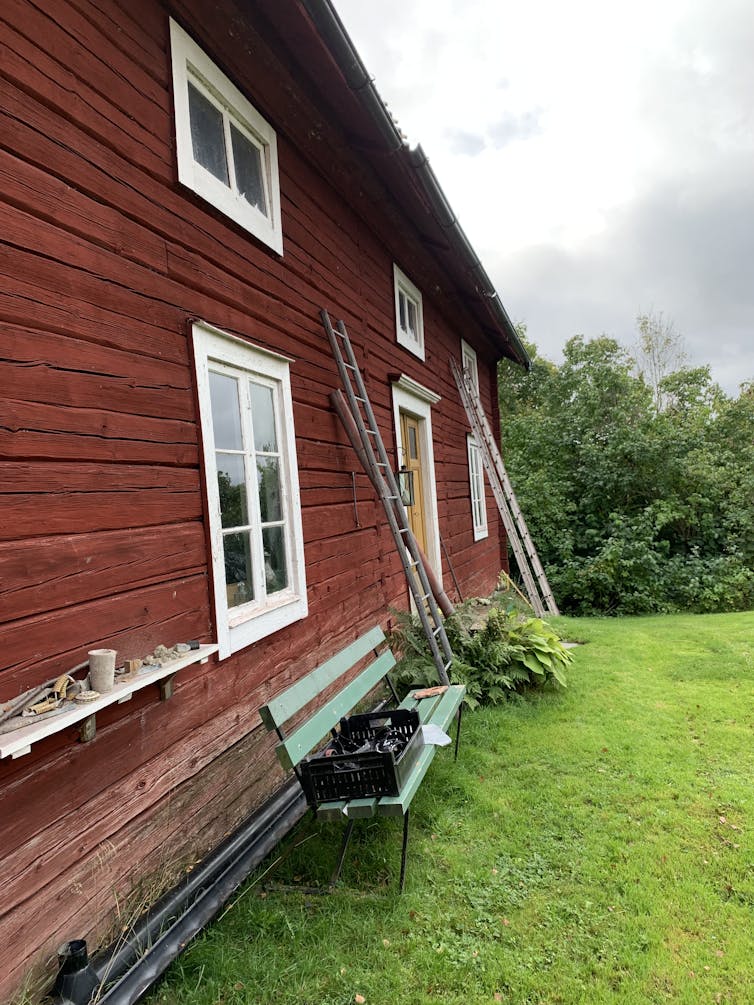
My grandmother and her siblings belonged to the adventurous pioneers who left their shoemaker heritage at a young age in the 1920s to move to Stockholm and make a living as housemaids and factory workers. None of them returned to Norrland other than to visit. One could say that they embodied the flight from the countryside, which through the years led to sparsely populated villages.
This change from “rural” to “depopulation” has turned into a discourse in Swedish culture: a development that is taken for granted and rarely questioned, and that we share with many other countries. The philosopher Simone Weil wrote about this in the 1940s. She means that the depopulation of the countryside leads to the death of society as a whole, and nothing seems to slow it down.
Against this background, it’s fair to say that Hälsingland today “finds itself caught in a present that began some time ago”, to borrow a phrase from the American anthropologist Kathleen Stewart.
The consequences of a century characterised by urbanisation and globalisation are ubiquitous and easily spotted in the landscape through the contours of disused factories, empty industrial buildings and closed shops. Abandoned houses line the roads. I find them hard to describe without flirting with the desolation and melancholy both captured and constructed by a special Nordic art genre – as the Finnish photographer Esko Männikkö’s compassionate photography of men living by themselves in depopulated villages, far away from the big industries and technological achievements – that many associate Sweden with.
Wolf howls
The Mother Earth ritual went into a new phase when shaman drums made our hearts beat faster, and then the howling began. The trees and the flames from the fire surrounded the witch. She moved her body to the sound of the drums. Other women joined, they let their heads drop backwards, and just howled towards the night sky.
I couldn’t help myself from smiling at “them”. I immediately hated myself a little bit for that smile: the constant need to be on top of things, controlling things, planning every inch of my existence, not being able to relax and go with the flow. The inability to be absorbed by special moments, like this one, is a disadvantage when doing ethnography. As an ethnologist you strive to “be there” – open, attentive, curious and never, ever condescending.
The last time I experimented with spiritual rituals was at the age of 11 together with my classmates. We were three girls who hid in the woods near school, performing black magic – very innocent black magic I should add, we didn’t get much further than genie in the bottle and attempted hypnosis. But we were so obsessed by our frightening and captivating games, where we explored our spiritual strength, or so we believed, that we forgot to return to the classroom when the school bell called. The teachers and the principal acted in the way you could expect them to act in Sweden in the early 1980s: they informed our parents about the inappropriate play and told us to immediately stop with this stupidness.
Nothing was offered to us in return that could still our spiritual longing, except one yearly visit to church before summer holidays. It seems like the Swedish people’s spiritual needs have been starved for quite some time now. The renowned Swedish author Agneta Pleijel, born in 1940, has written beautifully about her religiously anaemic childhood. Fostered by a father who was a professor in mathematics, she was taught that the world consisted of things that you could see, hear and feel and – above all – count and measure.
Scientific discoveries could cause a sense of wonder, yes, but Pleijel’s yearning for something bigger – destiny, fate, God or at least a feeling of meaning with it all – was met with snorts from her parents. It didn’t fit into the technocratic paradigm of our modern times which still reflects Sweden’s self-view to a higher degree than in many other more religiously oriented countries in Europe.
A female network-culture
During my stay in Hälsingland, I was literally swimming in overwhelming spiritual experiences. We meditated together in medieval churches, we practised yoga, we took long walks in the forest together with horses that the owner (a trained natural horsemanship practitioner) released among the trees. The horses ran off by themselves and returned to the herd when called for. The intelligent, attentive, and stunningly beautiful half-tonne animals moved with surprising softness and suppleness over the moss. “We do this regularly as you rarely meet any people in the forest”, I was told. So, this is what it might look like when the ordinary meets the extraordinary.
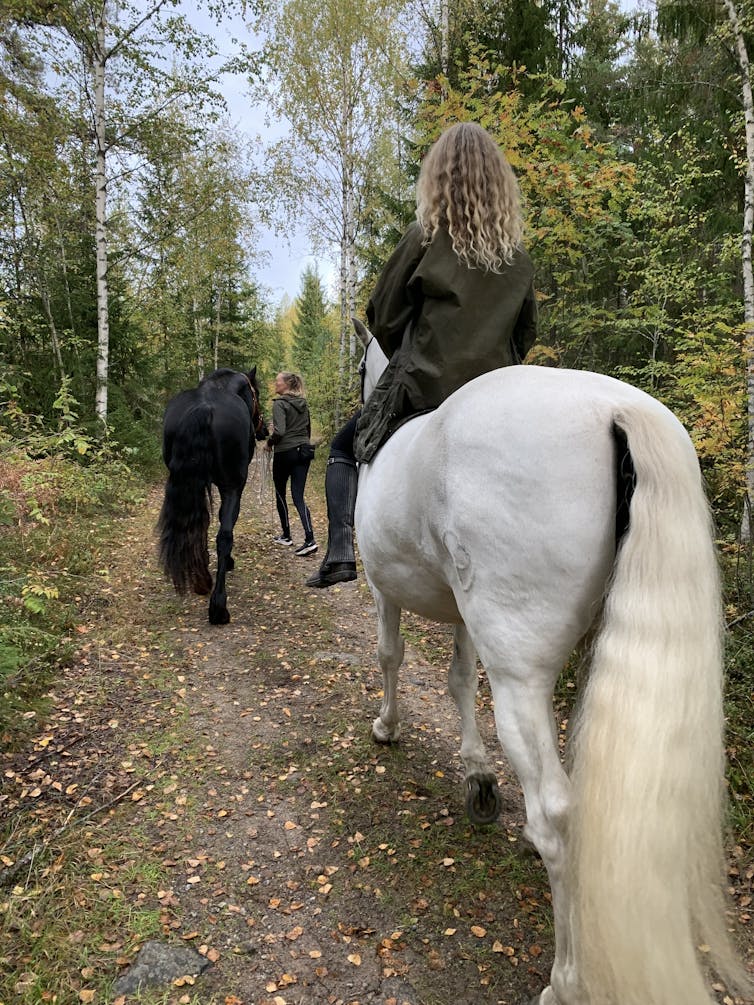
Over and above, intimate places emerged during the fieldwork, namely the female network-culture taking place through outdoor activities and long dinners in each other’s houses. This was a micro culture, that in subtle ways was interrelated with a local economy consisting of plenty of spare time, long car drives, low housing costs, handpicked mushrooms and moose meat served at the table and stored in the freezer. The women gathered food in the forest and took care of the meat that men brought to the household. They took active part of this modern hunting culture. And they had a tendency to answer my questions about vaccine reluctance in similar wording, told in determined yet soft voices.
Nobody will tell me what to do, because it’s my body. The same goes for our children – we know best what they need.
In my view, this underscores that people will act in accordance with recognised solidarity. In other words, what they believe that the majority of people in their community would do in a similar situation. The spirit fostered in these tight-knit communities became the trusted source of news and attitudes. This community of women trusted each other’s opinions more than anonymous national governing bodies. A strong local sense of belonging, as to a village or a landscape, and the loyalty with an intimate group of friends, in this particular case triumphed over the solidarity with a more anonymous, imagined community of the nation. And these bonds became even stronger because of the pandemic.
Some people said the main reason they got the vaccine was to express “solidarity” with the rest of their country. That may be a genuine reason for some. But I think it would be wrong to assume that all vaccine reluctant people lack feelings of solidarity.
However provocative it might come across, they might be loyal to other, more regional, local and intimate fellowships, as well as to like-minded people across the globe, and there are complex cultural and political reasons for this.
Or as Bernice Hausman, a professor at Pennsylvania State University, puts it from an American vantage point: “How, as a society, we deal with these circumstances of fundamental disagreement reflects how well our social contract is working.”
All things considered, my investigation underscores the importance of studying vaccine reluctance as something that is culturally specific. To make any sense it needs to be investigated less as de-contextualised opinions and arguments, and more as a socially and culturally embedded phenomenon.
Democracies are not one singular coherent public sphere, but many differing and conflicting public spheres.
The people I met were not “egoistic, ill-bred tearaway teenagers”, they were generous and considerate people. That I do not share their views about vaccinations does not mean that I cannot see myself reflected in them. They are my fellow human beings after all.
Names changed to protect the anonymity of those involved.

For you: more from our Insights series:
To hear about new Insights articles, join the hundreds of thousands of people who value The Conversation’s evidence-based news. Subscribe to our newsletter.

